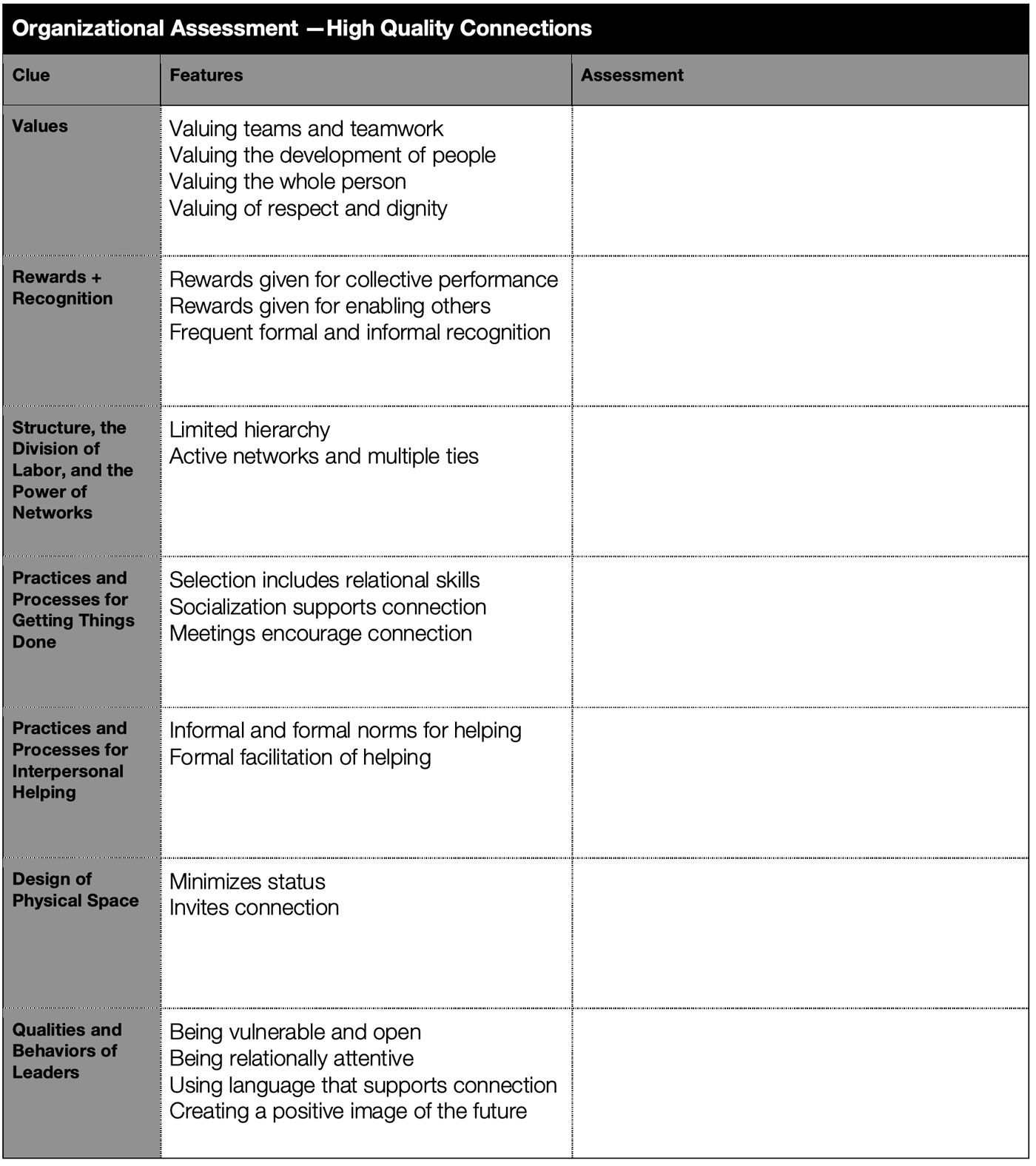
How often do we hear, “It’s all about relationships”? Relationships are the invisible but powerful trust glue through which we get our work done, accomplish big goals, and build community. But they can also be toxic, the bane of our daily misery, where goals go to die, or contort. Though so much of our work, never mind community, depends on relationships, up until recently there has not been much literature on relationships at work. Now, new thinking on what is being called “the power of high-quality connections” begins to offer us much needed language, frameworks, and practices for understanding and enacting positive relationships.
The high-quality connections work is led by Jane E. Dutton as part of a subfield of management and organizations called positive organizational scholarship created by Dutton and her team. In Energize Your Workplace: How to Create and Sustain High-Quality Connections at Work, she makes the case for how the quality of our relationships at work impact how organizations function. She writes, “The energy and vitality of individuals and organizations alike depends on the quality of the connections among people in the organization, and between organizational members and people outside the firm with whom they do business.” (1)
Dutton distinguishes between high- and low-quality connections. High-quality connections are characterized by “mutual positive regard, trust, and active engagement on both sides,” and low-quality connections by “distrust and disregard of the other’s worth.” (2)
The quality of these interactions is determined by whether it is experienced as life-giving or life-depleting. Life-giving interactions are built on paying attention, which is our most valuable resource and so we use it sparingly. They describe what it looks like at work.
The boss I had was extraordinary at taking me under his wing. He did things for me as a temp that I wasn’t used to. It was as if the minute I walked through the door I was, you know, I…was a permanent employee, even if I really wasn’t. He took me to lunch the first day. I mean he went over everything [the company] did in detail, he brought out all the materials, and he even talked about the political relationships of everyone in the department—his allies, management, this person and that person. This was the most delightful experience I’ve ever had.
Compare that to this.
The day he hired on, his assigned mentor showed him his new office and walked away without a word—no tour of the office, no introductions to co-workers, “in short, no information,” the consultant says. Later, in a meeting, a partner treated him like a piece of furniture. Pointing him out as a new hire, the partner said, “I don’t know if he’s any good. Somebody try him out and let me know,” he recalls.
We know which we’d prefer. Interactions can leave us elated or troubled. Social connections, even when short, often have lasting implications for both the individual and organization.
Further, the quality of connections facilitates the exchange of resources, including advice, support, money, political status, and development opportunities. They also shape identity, as work is a critical area for “identity display,” the opportunity to enact possible selves. And, critically, “an organization’s capacity to adapt and change is tied to the quality of the relationships between organizational members.”
High-quality connections are based on mutuality, the interchange of meaning, and the willingness to be changed by an interaction. Dutton offers three indicators for defining and gauging the quality of connections.
Sign up for our free newsletters
Subscribe to NPQ's newsletters to have our top stories delivered directly to your inbox.
By signing up, you agree to our privacy policy and terms of use, and to receive messages from NPQ and our partners.
- Greater emotional carrying capacity is the ability to express both positive and negative emotions.
- Tensility is the capacity to accommodate disagreements and conflict.
- Degree of connectivity is skill in amplifying possibilities and minimizing behaviors that close off possibilities.
Dutton considers managers the architects of organizational context and thus their job is to build contexts that support high-quality connections. She offers the following clues.
Clue 1 | Culture and the Power of Values
In her research, Dutton finds four values that are particularly important to fostering high-quality connections. The first, the valuing of teamwork, means orienting people toward learning and helping each other. Valuing the development of people is about encouraging people to get in touch with and express their passions and needs. Valuing the whole person, the third value, supports employees in honoring other life commitments, like family. Finally, valuing respect and the dignity of others means clarity about the respect we are all entitled to as people, regardless of status.
Clue 2 | The Design of Rewards and Recognition
Dutton finds that fostering high-quality connections requires incentives for linkages. Two features are particularly important in diagnosing which incentives you have. The first is whether rewards are based on collective, as well as individual, performance. Are teams rewarded for their accomplishments? The second is whether people are rewarded for developing and enabling others. She finds that great companies are “marked by collegial relationships that often last for life.” (145)
Clue 3 | Structure, the Division of Labor, and the Power of Networks
Since “dividing and layering” organizations creates separation and inequality, Dutton finds that limited hierarchy enables high-quality connections because these thrive in contexts of mutuality. In addition to few layers, not offering perks to executives not offered employees, or offering perks to employees not offered executives, is important. Symbolic differences should also be minimized. Bigger or corner offices are understood to often simply be signs of status, rather than practical. While vertical relationships are minimized, horizontal relationships, such as networks, are encouraged, especially multiple ties.
Clue 4 | Practices and Processes for Getting Things Done
Through these practices, we evolve. We learn to move closer or farther away from each other. There are three Dutton has identified as critical for high-quality connections. The first are practices for selection, or how the organization hires. For example, organizations can hire for relational skills. The second, socialization, are the means by which an organization helps an employee become an insider in the system. Some organizations assign an advocate to help a newcomer move through the system and develop relationships. The third are the practices used in meetings. Are they run in ways that help participants quickly understand the roles and agenda? Do they reward people for listening to each other? Are they lively and fun? Meetings that help participants be productive and enjoy each other cultivate high-quality connections.
Clue 5 | Practices and Processes for Interpersonal Helping
Organizations where people teach and help each other help foster high-quality connections. Not only is it important to encouraging these, we must tell stories about how they occur. These stories often contain the wisdom of the organization. Dutton finds that some organizations even have systems in place that facilitate the coordination of care and help when employees need it.
Clue 6 | Design of Physical Space
Like many others, Dutton observes that the physical space of an organization reveals a lot about how likely people are to be connected, and even the quality of those connections. Does it invite physical connection? Does it create strong or weak status differences between people? People are separated not only by physical barriers, but by status distinctions. These get in the way of information sharing and rapid responses.
Clue 7 | Leadership Qualities and Behaviors
There are certain qualities and behaviors that signal a leader’s commitment to building an organization that fosters high-quality connections. Dutton identifies four. The first is being open and vulnerable. This means not getting defensive when things go wrong. It means admitting when you’re wrong. When a leader models this, employees reciprocate. Leaders who are relationally attentive are more likely to create contexts that support high-quality connections. They know when the culture is toxic and how to “fertilize” it. They notice emotional changes in others, and it matters enough for them to address it respectfully. They also know how to maximize joy in big moments and the pleasures of everyday work life.
In addition to action, the power of leaders is reflected in their words. A leader’s language and stories can unite or separate. For example, rather than “using the language of conflict and interest,” a leader can tap into language that invites “people to reach out and try to connect with one another.” (165) Finally, leaders foster high-quality connections by creating positive images of the future. This helps employees channel the energy that high-quality connections create. Positive images of the organization help people create positive expectations of their colleagues. It makes people focus less on themselves and strengthens solidarity. It also unleashes hope, which makes people feel taken care of and inspired to make a difference in the world.
This is the kind of organization in which most of us would probably like to work. Nonprofits, with our focus on social change, need to be these kinds of organizations to move towards our missions. How is your organization doing?














